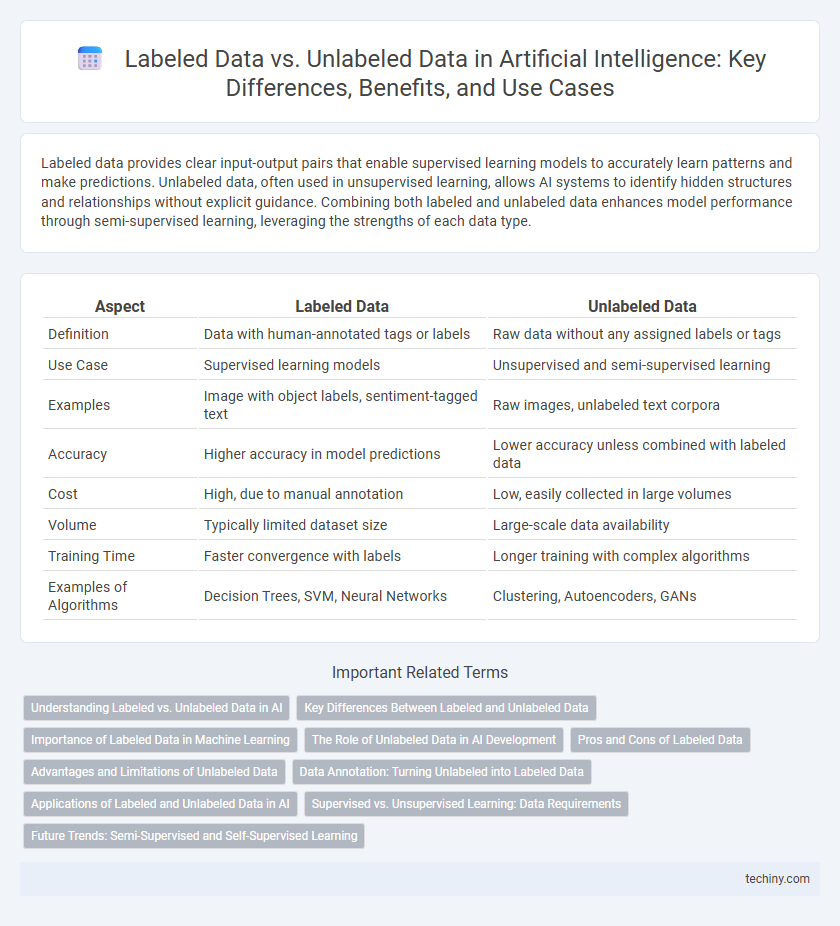Labeled data provides clear input-output pairs that enable supervised learning models to accurately learn patterns and make predictions. Unlabeled data, often used in unsupervised learning, allows AI systems to identify hidden structures and relationships without explicit guidance. Combining both labeled and unlabeled data enhances model performance through semi-supervised learning, leveraging the strengths of each data type.
Table of Comparison
| Aspect | Labeled Data | Unlabeled Data |
|---|---|---|
| Definition | Data with human-annotated tags or labels | Raw data without any assigned labels or tags |
| Use Case | Supervised learning models | Unsupervised and semi-supervised learning |
| Examples | Image with object labels, sentiment-tagged text | Raw images, unlabeled text corpora |
| Accuracy | Higher accuracy in model predictions | Lower accuracy unless combined with labeled data |
| Cost | High, due to manual annotation | Low, easily collected in large volumes |
| Volume | Typically limited dataset size | Large-scale data availability |
| Training Time | Faster convergence with labels | Longer training with complex algorithms |
| Examples of Algorithms | Decision Trees, SVM, Neural Networks | Clustering, Autoencoders, GANs |
Understanding Labeled vs. Unlabeled Data in AI
Labeled data consists of input-output pairs with known annotations, crucial for supervised learning algorithms to map features to targets accurately. Unlabeled data lacks explicit annotations, requiring unsupervised or semi-supervised methods to identify patterns or cluster information without predefined labels. Effective AI models often integrate both labeled and unlabeled data to improve learning efficiency and generalization across diverse datasets.
Key Differences Between Labeled and Unlabeled Data
Labeled data consists of input-output pairs where each data point is tagged with meaningful labels, enabling supervised learning models to map inputs to specific outcomes with high accuracy. Unlabeled data lacks explicit tags or annotations, requiring unsupervised or semi-supervised learning algorithms to identify patterns or group similar data points without predefined categories. The key difference lies in their usability: labeled data drives predictive modeling with clear guidance, while unlabeled data is essential for discovering hidden structures and supporting models when labeled datasets are scarce or costly.
Importance of Labeled Data in Machine Learning
Labeled data is crucial in machine learning as it provides the necessary ground truth for supervised learning algorithms to accurately identify patterns and make predictions. High-quality labeled datasets enable models to learn specific features and improve classification, regression, and object recognition tasks. The scarcity of labeled data often limits model performance, making data annotation and labeling techniques essential for advancing artificial intelligence applications.
The Role of Unlabeled Data in AI Development
Unlabeled data plays a crucial role in AI development by enabling models to learn patterns from vast amounts of raw, unannotated information through unsupervised and semi-supervised learning techniques. This data type enhances model generalization and reduces the reliance on expensive, labor-intensive labeled datasets, driving advancements in natural language processing, computer vision, and speech recognition. Leveraging unlabeled data accelerates AI innovation by providing broader context and improving the ability of algorithms to understand complex, real-world scenarios.
Pros and Cons of Labeled Data
Labeled data provides precise annotations for training AI models, enhancing accuracy and enabling supervised learning tasks such as image recognition and natural language processing. The major advantage lies in its ability to improve model performance and interpretability, while the primary drawback is the high cost and time consumption required for manual labeling. Limited scalability and potential human error in annotations can also restrict the dataset's effectiveness in diverse or evolving applications.
Advantages and Limitations of Unlabeled Data
Unlabeled data offers the advantage of vast availability, enabling models to learn from diverse and large-scale datasets without the costly and time-consuming annotation process. It facilitates unsupervised and semi-supervised learning approaches, which can uncover hidden patterns and structures that labeled data might miss. However, unlabeled data presents limitations such as reduced accuracy in predictive tasks and the challenge of requiring complex algorithms to extract meaningful features compared to the straightforward use of labeled data.
Data Annotation: Turning Unlabeled into Labeled Data
Data annotation plays a crucial role in transforming unlabeled data into labeled data, which is essential for supervised learning in artificial intelligence. Techniques such as manual tagging, crowdsourcing, and automated labeling algorithms enable the identification of relevant features within raw datasets. High-quality labeled data improves model accuracy and enables more effective training of machine learning algorithms.
Applications of Labeled and Unlabeled Data in AI
Labeled data powers supervised learning algorithms by enabling models to accurately classify images, recognize speech, and detect fraudulent transactions using annotated examples. Unlabeled data drives unsupervised learning techniques like clustering and anomaly detection, facilitating customer segmentation, market basket analysis, and discovering hidden patterns without predefined categories. Semi-supervised learning leverages both data types, enhancing natural language processing tasks and medical diagnosis accuracy while reducing the need for extensive manual labeling.
Supervised vs. Unsupervised Learning: Data Requirements
Supervised learning relies heavily on labeled data, where each input is paired with a corresponding output, enabling models to learn precise patterns for tasks such as image classification and speech recognition. Unsupervised learning uses unlabeled data to identify inherent structures or patterns through clustering or dimensionality reduction methods, making it essential for applications like anomaly detection and data segmentation. The quality and quantity of labeled data directly impact the accuracy of supervised models, while unsupervised approaches depend on the diversity and complexity of input data to discover meaningful insights.
Future Trends: Semi-Supervised and Self-Supervised Learning
Semi-supervised and self-supervised learning are transforming the future of artificial intelligence by leveraging both labeled and unlabeled data to enhance model accuracy and reduce dependency on extensive labeled datasets. These approaches enable AI systems to learn meaningful representations from vast amounts of unlabeled data, driving advancements in areas like natural language processing and computer vision. Growing research investments and improved algorithmic techniques are accelerating the adoption of these learning paradigms, promising more efficient and scalable AI solutions.
Labeled Data vs Unlabeled Data Infographic

 techiny.com
techiny.com